Abstract
Background
Phenylketonuria is an inherited disease treated with dietary restriction of the amino acid phenylalanine. The diet is initiated in the neonatal period to prevent learning disability; however, it is restrictive and can be difficult to follow. Whether the diet can be relaxed or discontinued during adolescence or should be continued for life remains a controversial issue, which we aim to address in this review. This is an updated version of a previously published review.
Objectives
To assess the effects of a low‐phenylalanine diet commenced early in life for people with phenylketonuria. To assess the possible effects of relaxation or termination of the diet on intelligence, neuropsychological outcomes and mortality, growth, nutritional status, eating behaviour and quality of life.
Search methods
We searched the Cochrane Cystic Fibrosis and Genetic Disorders Group Trials Register comprising references identified from comprehensive electronic database searches, handsearches of relevant journals and abstract books of conference proceedings.
Most recent search of the Inborn Errors of Metabolism Trials Register: 30 April 2020.
Selection criteria
All randomised or quasi‐randomised controlled trials comparing a low‐phenylalanine diet to relaxation or termination of dietary restrictions in people with phenylketonuria.
Data collection and analysis
Two authors independently assessed study eligibility and methodological quality, and subsequently extracted the data.
Main results
We included four studies in this review (251 participants), and found few significant differences between treatment and comparison groups for the outcomes of interest. Blood phenylalanine levels were significantly lower in participants with phenylketonuria following a low‐phenylalanine diet compared to those on a less restricted diet, mean difference (MD) at three months ‐698.67 (95% confidence interval (CI) ‐869.44 to ‐527.89). Intelligence quotient was significantly higher in participants who continued the diet than in those who stopped the diet, MD after 12 months 5.00 (95% CI 0.40 to 9.60). However, these results came from a single study.
Authors' conclusions
The results of non‐randomised studies have concluded that a low‐phenylalanine diet is effective in reducing blood phenylalanine levels and improving intelligence quotient and neuropsychological outcomes. We were unable to find any randomised controlled studies that have assessed the effect of a low‐phenylalanine diet versus no diet from diagnosis. In view of evidence from non‐randomised studies, such a study would be unethical and it is recommended that low‐phenylalanine diet should be commenced at the time of diagnosis. There is uncertainty about the precise level of phenylalanine restriction and when, if ever, the diet should be relaxed. This should be addressed by randomised controlled studies; however, no new studies are expected in this area so we do not plan to update this review.
Keywords: Child, Preschool; Humans; Intelligence; Phenylalanine; Phenylalanine/administration & dosage; Phenylalanine/blood; Phenylketonurias; Phenylketonurias/blood; Phenylketonurias/diet therapy; Randomized Controlled Trials as Topic; Treatment Outcome; Withholding Treatment
Plain language summary
Using diet to manage phenylketonuria
Review question
We reviewed the evidence about the effects of a low‐phenylalanine diet started early in life in people with phenylketonuria. We also aimed to assess the possible effects of relaxing or stopping the diet on intelligence, quality of life and other outcomes. This is an updated version of a previously published review.
Background
Phenylketonuria is an inherited disease treated with dietary restriction of the amino acid phenylalanine. The diet is started in newborns to prevent learning disability; however, it is restrictive and can be difficult to follow. Whether the diet can be relaxed or stopped during adolescence or should be continued for life remains a controversial issue, which we aim to address in this review.
Search date
The evidence is current to: 30 April 2020.
Study characteristics
The review included four studies with 251 people with phenylketonuria. One study looked at the effects of stopping a low‐phenylalanine diet at four years of age, a second study looked at the effect of returning to low‐phenylalanine diets in children who had previously relaxed their diet, a third study looked at the effect of increasing phenylalanine intake in children who had continued on a low‐phenylalanine diet since diagnosis and the fourth (a large, multicentre study) investigated the use of a strict low‐phenylalanine diet compared to a moderately strict low‐phenylalanine diet in newly diagnosed children.
Key results
Given the differences between the studies, we were unable to combine many results across the four studies. We found few major differences between treatment and comparison groups for the outcomes of interest. Blood phenylalanine levels were significantly lower in participants with phenylketonuria following a low‐phenylalanine diet compared to those on a less restricted diet, mean difference (MD) at three months ‐698.67 (95% confidence interval (CI) ‐869.44 to ‐527.89). Intelligence quotient was significantly higher in participants who continued the diet than in those who stopped the diet, MD after 12 months 5.00 (95% CI 0.40 to 9.60). However, these results came from a single study. More research is needed to show if it is safe to relax this diet later on; however, no new studies are expected in this area so we do not plan to update the review.
Quality of the evidence
The overall quality of the evidence varied across studies.
Background
Description of the condition
Phenylketonuria (PKU) is an inherited disease which affects 100 cases per million live births in Caucasian and Asian populations (Scriver 1995). PKU is characterised by an absence or deficiency of phenylalanine hydroxylase (a liver enzyme involved in the breakdown of the essential amino acid phenylalanine to tyrosine). In classical PKU there is a total, or almost total, deficiency of phenylalanine hydroxylase leading to high blood phenylalanine concentrations of 1200 μmol/L or more (Scriver 1995). In some cases blood phenylalanine concentrations are persistently raised above 400 μmol/L, but not to the levels seen in classical PKU, although some degree of phenylalanine hydroxylase activity remains present. These conditions are called the hyperphenylalaninaemias. However, for the purpose of this review the term PKU will be used to include both classical PKU and the hyperphenylalaninaemias.
In infants with PKU, the blood phenylalanine concentration is within the normal range at birth, but becomes elevated, usually within several hours to a few days of commencing a normal dietary intake. This can lead to neurological damage and learning disability if left untreated (Paine 1957). In infants with less severe phenylalanine hydroxylase deficiency the occurrence of brain damage is more variable.
Description of the intervention
The results of a number of cohort studies have indicated that dietary treatment of PKU is effective in preventing or reducing learning disability, if initiated within the first twenty days of life (MRC1 1993). However, the recommended diet has several disadvantages, as it is a difficult regimen to follow and requires regular support from a specialist team. In addition, the dietary restrictions may result in inappropriate eating behaviour patterns and nutritional deficiencies (Smith 1994). The aim of the diet is to achieve blood phenylalanine concentrations within the recommended levels and to promote normal growth and development (MRC1 1993). This is achieved by the exclusion of high protein foods, which contain high concentrations of phenylalanine, for example meat, fish, cheese and eggs. However, phenylalanine is an essential amino acid and cannot be totally excluded from the diet. Therefore, the appropriate daily phenylalanine intake is provided by carefully measured quantities of foods containing lower concentrations of phenylalanine, for example, potatoes, baked beans and cereal products. These are called exchanges. The dietitian provides people with PKU and their families with a list of exchanges; the number of these varies according to the person's blood phenylalanine concentrations, which are regularly monitored. Foods that contain minimal amounts of phenylalanine, for example some fruits and vegetables, fats and sugar, can be taken freely. Special prescribable low‐protein products are available in some countries to supplement the energy content and increase the variety of the diet. In addition to the dietary restrictions, people with PKU must consume a very low phenylalanine or phenylalanine‐free amino acid supplement on a daily basis. This replaces the essential amino acids and other nutrients, which may be deficient in the restricted diet (Dixon 1994). Care should be taken, as some of the amino acid supplements require additional supplementation with vitamins and minerals. In addition, these products are generally considered to be unpalatable; therefore close monitoring of compliance and the nutritional adequacy of the diet is essential to ensure adequate growth and to avoid nutritional deficiencies.
It is accepted that all children with PKU should be started on the diet as early as possible, but controversies exist around the issue of when, if at all, it is safe for dietary restrictions to be lifted or relaxed (Michals 1988). Previously, different recommendations have been made on the most appropriate age at which relaxation or discontinuation of the diet should occur, for example by the time the child with PKU has started school or when the child has reached early adolescence. However, recent research has indicated that older children and adults with PKU who have discontinued dietary restrictions may experience upper motor neurone disturbances (MRC2 1993). Magnetic resonance imaging has also shown that high blood concentrations of phenylalanine in later childhood and adulthood can result in changes to the white matter of the brain (Smith 1994). In light of these studies, the Medical Research Council Working Party on Phenylketonuria issued a series of recommendations on the dietary management of PKU in the United Kingdom in 1993 (MRC1 1993). Similar recommendations are followed in other countries (Fisch 1997).
Why it is important to do this review
People with PKU have received inconsistent advice about when to stop or relax dietary treatment since Bickel first introduced the diet (Bickel 1953). This has resulted in a population of people with PKU who have followed a variety of levels of dietary restrictions over differing lengths of time. This is an updated version of a previously published review (Poustie 1999; Poustie 2010).
Objectives
The aim of this review is to examine evidence that in people with PKU:
a low‐phenylalanine diet started early in infancy improves neuropsychological performance and intelligence, and affects a number of other outcomes (listed under 'Types of outcome measures' below);
relaxation or discontinuation of dietary treatment in PKU has an adverse effect on neuropsychological performance and intelligence, and a number of other outcomes (listed under 'Types of outcome measures' below).
Methods
Criteria for considering studies for this review
Types of studies
Randomised controlled trials (RCTs), both published and unpublished. Trials, where quasi‐randomisation methods such as alternation are used, will be included in future updates of this review if there is sufficient evidence that the treatment and comparison groups were comparable in terms of clinical and nutritional status.
Types of participants
Individuals of any age with phenylketonuria and other forms of phenylalanine hydroxylase deficiency, diagnosed by the Guthrie test or another recognised, validated screening test and in whom dietary intervention was commenced early in life.
Types of interventions
Restriction of dietary phenylalanine and administration of phenylalanine‐free or very low phenylalanine amino acid supplement initiated early in life as advised by a specialist PKU team and either continued for life or relaxed or discontinued at any point during the life of the person with PKU. This intervention being compared to unrestricted diet or less strict levels of phenylalanine restriction (with or without administration of very low phenylalanine or phenylalanine‐free amino acid supplements).
Types of outcome measures
Primary outcomes
Blood phenylalanine concentration
Measures of neuropsychological performance
Measures of intelligence
Secondary outcomes
Blood tyrosine concentration
Weight gain or body mass index or z scores or centiles or other indices of nutritional status or growth
Energy and nutrient intake
Measures of eating behaviour
Measures of quality of life
Death
Search methods for identification of studies
Relevant studies were identified from the Group's Inborn Errors of Metabolism Trials Register using the term: diet.
The Inborn Errors of Metabolism Trials Register is compiled from electronic searches of the Cochrane Central Register of Controlled Trials (CENTRAL) (updated with each new issue of the Cochrane Library), weekly searches of MEDLINE and the prospective handsearching of one journal ‐ Journal of Inherited Metabolic Disease. Unpublished work is identified by searching through the abstract books of the Society for the Study of Inborn Errors of Metabolism conference and the SHS Inborn Error Review Series. For full details of all searching activities for the register, please see the relevant section of the Cochrane Cystic Fibrosis and Genetic Disorders Group's website.
Additional RCTs were found from reference lists. Manufacturers of the phenylalanine‐free and very low phenylalanine protein supplements were contacted to ask if they had data from published and unpublished RCTs on file.
Date of the most recent search of the Group's Inborn Errors of Metabolism Trials Register: 30 April 2020.
Data collection and analysis
Selection of studies
The two authors independently selected the studies to be included in the review.
Data extraction and management
Both authors independently extracted data.
Assessment of risk of bias in included studies
The two authors independently assessed the methodological quality of the included studies using a method described by Schulz (Schulz 1995) and related this to the risk of bias. This method focuses on four areas: allocation concealment; generation of the randomisation sequence; intention‐to‐treat analysis; and blinding. The authors graded the concealment of allocation to the investigators of participants to treatment groups as being adequate, unclear or inadequate. The authors also used the same three categories to assess the method used to generate the randomisation sequence. In both cases, an 'adequate' grade related to a low risk of bias, an 'unclear' grade related to an unclear risk of bias and an 'inadequate' grade related to a high risk of bias. Use of an intention‐to‐treat analysis was assessed using the categories: adequate; unclear; or exclusions (i.e. participants were excluded from the final analysis), where adequate related to a low risk of bias, unclear to an unclear risk of bias and exclusions to a high risk of bias. The authors considered the level of blinding, although they noted that it is difficult to blind participants when treatment involves dietary manipulation. However, it should be possible for the investigators to be blinded to which treatment group the participant is in, even if the participant is aware of group allocation. The more people that were blinded to an intervention led to a lower risk of bias. Had the two authors disagreed about the quality of a study, then they would have resolved the disagreement by discussion until they reached a consensus.
Measures of treatment effect
For binary outcome measures we planned to calculate a pooled estimate of the treatment effect for each outcome across studies, (the odds of an outcome among treatment allocated participants to the corresponding odds among controls). For continuous outcomes, we recorded either mean change from baseline for each group or mean post‐treatment or intervention values and standard deviation or standard error for each group. Where possible, we calculated a pooled estimate of treatment effect by calculating the mean difference (MD) with 95% confidence intervals (CI).
Outcome data were grouped into those measured at one, three, six, twelve months and annually thereafter. If outcome data are recorded at other time periods, we would consider examining these as well.
Unit of analysis issues
Where the authors included studies of cross‐over design in the review, they ideally used paired data in the analysis to allow a within‐individual comparison of the intervention. Where such data were not available, the authors used data from the first arm of the study only in the analysis. If this was not possible, they employed an unsatisfactory approach of using the combined results, thereby ignoring the cross‐over design (Elbourne 2002).
Dealing with missing data
In order to allow an intention‐to‐treat analysis, we will seek data on the number of participants by allocated treatment group, irrespective of compliance and whether or not the participant was later thought to be ineligible or otherwise excluded from treatment or follow up.
Assessment of heterogeneity
The authors planned to test for heterogeneity between study results, using a standard Chi² test.
Subgroup analysis and investigation of heterogeneity
The authors may perform subgroup analysis (stratifying according to type of control group(s) used, age and level of dietary restriction) for future updates.
Sensitivity analysis
The authors planned to perform a sensitivity analysis based on the methodological quality of the studies, including and excluding quasi‐randomised studies.
Results
Description of studies
Results of the search
Thirty‐nine references to twenty‐two separate studies were identified as relevant from the searches.
For the 2020 update, a further 228 references were identified which were discarded on title alone.
Included studies
We included four studies (19 references) in this review, with a total of 251 participants (Clarke 1987; Griffiths 1998; Holtzman 1975; US/PKU Collaborative). Two of these studies employed a cross‐over design (Clarke 1987; Griffiths 1998). Combined group data only were available from these two studies, which meant that the unsatisfactory approach of ignoring the cross‐over design had to be employed to allow these data to be included in the analysis. The study by Holtzman investigated the effects of termination of low‐phenylalanine diet at four years of age (Holtzman 1975). The study by Clarke looked at the effect of returning to low‐phenylalanine diets in children who had previously relaxed their diet. It was noted that two of the participants who were included in the study had actually continued on a low‐phenylalanine diet before starting the study (Clarke 1987). The study by Griffiths investigated the effect of increasing phenylalanine intake in children who had continued on a low‐phenylalanine diet since diagnosis (Griffiths 1998). The US/PKU collaborative study, a large, multicentre, randomised study, investigated the use of a strict low‐phenylalanine diet compared to a moderately strict low‐phenylalanine diet in newly diagnosed children with PKU (US/PKU Collaborative). The majority of the children started the diet early in life; however, in some participants the diet was not initiated for up to 121 days, which would be considered late according to current recommendations. The participants were followed up regularly until their sixth birthdays, when half were randomised to continue the diet and half were randomised to terminate the diet. The participants then continued to be monitored until, in some cases, into adulthood.
Excluded studies
Eighteen studies (20 references) were excluded from the review. Full details for the reasons for exclusion can be found in the tables (Characteristics of excluded studies).
Risk of bias in included studies
Allocation
Generation of randomisation sequence was adequate (with a low risk of bias) in only one of the included studies (US/PKU Collaborative). In this study treatment groups were "randomly formed" using table of random numbers. Generation of randomisation sequence was unclear in the remaining three included studies leading to an unclear risk of bias for these studies (Clarke 1987; Griffiths 1998; Holtzman 1975).
Allocation concealment was not discussed in two of the studies, which therefore had an unclear risk of bias (Clarke 1987; Holtzman 1975). Allocation concealment was judged adequate in two studies; we therefore judged these studies to have a low risk of bias (Griffiths 1998; US/PKU Collaborative). In the Griffiths study, the usual formula and experimental product were both prepared and coded by pharmaceutical company and the key to the code kept by a senior member of the hospital medical staff (Griffiths 1998). In the US PKU Collaborative study the allocation schedule was produced by project staff in telephone contact with local clinic staff at participating clinics (US/PKU Collaborative).
Blinding
Two studies were triple‐blind, which was achieved by the participants continuing on their usual diet but with the phenylalanine content of the diet manipulated by using additional supplements (Clarke 1987; Griffiths 1998). We therefore judge these studies to have a low risk of bias for blinding of participants, clinicians and the outcome assessors. The other two studies did not blind the participants or the clinicians, but the outcome assessors were blinded to treatment groups; we therefore judge these to have a low risk of bias for the outcome assessors, but a high risk of bias from lack of blinding of the participants and clinicians (Holtzman 1975; US/PKU Collaborative).
Incomplete outcome data
Intention‐to‐treat analysis was employed in two of the studies, so we judged these to have a low risk of bias (Clarke 1987; Griffiths 1998). We judge the other two studies to have an unclear risk of bias, since there were several drop outs from the studies, but reasons for these were briefly described in the published papers (Holtzman 1975; US/PKU Collaborative). In one study, data on some of the participants were missing at several of the intermediate time points and at the end of the study (Holtzman 1975). In the US PKU study, a relatively high proportion of participants were lost to follow up and some participants swapped groups after randomisation (US/PKU Collaborative). In addition, many of the study reports combine the results of the groups. This makes analysis difficult or impossible. We have contacted the principal investigator to obtain further details of the individual patient data; however, as yet, this has been unsuccessful.
Effects of interventions
Primary outcomes
1. Blood phenylalanine concentration
This outcome was measured in all of the studies. The US/PKU collaborative study measured this outcome on a regular basis for up to 12 years (US/PKU Collaborative). The analysis shows that blood phenylalanine concentrations were significantly lower in the participants on the low‐phenylalanine diet than those on a less restricted diet; MD at three months was ‐698.67 (95% CI ‐869.44 to ‐ 527.89), based on the results of two studies. In the study comparing a low‐phenylalanine diet to a less restricted diet from diagnosis, the blood phenylalanine concentrations were significantly lower in the participants on the low‐phenylalanine diet. However, these results are based on only one study (US/PKU Collaborative).
2. Blood tyrosine concentration
This outcome was not measured in any of the studies.
3. Weight gain and other measures of nutritional status
This outcome was measured in only two studies (Holtzman 1975; US/PKU Collaborative). The US/PKU collaborative study measured weight, height and head circumference of participants over four years (US/PKU Collaborative). Unfortunately, they only reported the combined results of the treatment and control groups, but we are trying to obtain the individual data from the trialists. However, data were available on weights of the two groups of participants for the first year. In the study by Holtzman, the number of participants in each group was very small and no standard deviations were reported (Holtzman 1975). It was reported that height and head circumference data were also collected in this study, although the data were not presented in the published report. No significant differences were found between mean weights of the two groups at any time point.
4. Neuropsychological performance
More than 30 different assessments of neuropsychological performance were carried out in the four studies. Only three of the measures were used in more than one study, although final data from these assessments were not available. Therefore, this outcome was not assessed.
5. Intelligence quotient
Three of the studies assessed intelligence quotient (IQ) (Clarke 1987; Holtzman 1975; US/PKU Collaborative). One study did not report the results of the IQ test, although we have contacted the trialists to gain further information (Clarke 1987). Another study did not provide standard deviations for the results (Holtzman 1975). The US/PKU collaborative study found no significant difference between the IQ of participants, who were initiated on a strict low‐phenylalanine diet at diagnosis, compared to those who received a less strict low‐phenylalanine diet from diagnosis (US/PKU Collaborative). However, following the second randomisation at six years of age, those participants who were randomised to continue the low‐phenylalanine diet achieved a higher IQ than those who were randomised to discontinue the diet. This result was significant after 12 months, MD 5.00 (95% CI 0.40 to 9.60).
6. Energy & protein intake
Energy and protein intake were assessed in only one of the studies; no significant differences were found between the treatment and comparison groups (US/PKU Collaborative). This study also assessed median phenylalanine intakes over six‐monthly periods between the ages of 15 months and 6 years. The children in the group receiving the strictly controlled diet had significantly lower median phenylalanine intakes than those on the less strictly controlled diet. It should be noted that these results are based on data from one study only (US/PKU Collaborative).
Secondary outcomes
1. Eating behaviour
This outcome was not measured in any of the studies.
2. Quality of life
This outcome was not measured in any of the studies.
3. Mortality
This outcome was not measured in any of the studies.
Discussion
The recommended diet for the treatment of PKU is very restricted. This has implications for the nutritional status, growth and quality of life of people with PKU. Due to the relatively small numbers of people with PKU, most studies involve only small numbers of participants. This is reflected in the studies considered in this review, with the maximum number of participants in a study being 216, although the data from all these participants were not included in the published report (US/PKU Collaborative). Several of the included studies did not provide details on allocation concealment or generation of randomisation sequence. Only two of the four studies employed an intention‐to‐treat analysis (Clarke 1987; Griffiths 1998). As would be expected, blood phenylalanine concentration, which was assessed in all the studies, was found to be significantly higher in people with PKU on a relaxed phenylalanine diet than in those on a low‐phenylalanine diet. The outcome measures used to assess neuropsychological performance varied from study to study, and it was therefore impossible to combine the results of the studies statistically. The published reports of these studies confounded the situation further by omitting some data.
Only one study investigated the effects of different levels of phenylalanine restriction commenced at diagnosis (US/PKU Collaborative). This study failed to find any significant results other than for blood phenylalanine level and median phenylalanine intake during the first six years of the study. The second stage of this study, which assessed the effect of continuation or termination of the diet at six years of age, found a significant difference between the IQ of those participants who continued the diet compared to those who terminated the diet. This suggests that continuation of the low phenylalanine diet has a beneficial effect on IQ. The remaining studies also investigated the effect of terminating or re‐commencing the diet at some point later in life, after the diet had been initiated at diagnosis, although we were unable to combine any further results for IQ with those of the US/PKU collaborative study (US/PKU Collaborative). We know from sources of evidence other than RCTs, that a high proportion of children with PKU who do not receive any dietary manipulation develop learning disability and neurological impairment (MRC2 1993). It would thus be unethical to withhold treatment from people with PKU at diagnosis; however, it may be useful to study the level of restriction required from diagnosis in a study similar to that of the US/PKU collaborative study (US/PKU Collaborative). It is disappointing that the studies available included only small numbers of participants and have not followed them into adulthood.
Authors' conclusions
Implications for practice.
Due to the lack of good quality RCTs in this review, no conclusions can be drawn about the effectiveness of specific dietary interventions in PKU. As a result of the concerns about learning disability and neurological damage in untreated PKU, current recommendations to commence a low‐phenylalanine diet at diagnosis should continue to be observed. However, there is a lack of clear evidence about the precise level of phenylalanine restriction or when, if ever, the restricted diet could be relaxed. A large, well‐designed, adequately‐powered RCT is necessary to provide further information. Many centres would need to be involved to achieve this. Therefore, it is recommended that people with PKU should not be entered into small studies, which would then exclude them from entering into a larger study.
Implications for research.
A large, well‐designed, adequately‐powered, randomised, controlled, double‐blind study is necessary to assess the effect of termination of dietary restrictions in PKU. Careful consideration should be given to the inclusion criteria. It may also be useful to assess the effect of different levels of dietary restrictions initiated from diagnosis. Due to the low incidence of PKU in the population, it is essential that any such study be multicentre and possibly international. It would be necessary to ascertain which outcome measures are most appropriate, and to reach a consensus on which measures of intelligence and neuropsychological performance should be used. It would also be beneficial if people with PKU, or their parents, could be involved in the design of the study to ensure that the most important and relevant aspects are considered. However, currently, no new studies are expected in this area so we do not plan to update the review.
What's new
| Date | Event | Description |
|---|---|---|
| 8 April 2021 | Review declared as stable | Research area inactive, therefore, we do not plan on updating this review. |
History
Protocol first published: Issue 4, 1998 Review first published: Issue 3, 1999
| Date | Event | Description |
|---|---|---|
| 30 April 2020 | New citation required but conclusions have not changed | Minor changes have been made throughout the review. The Cochrane Cystic Fibrosis and Genetic Disorders Group's Editorial Board has decided to close this review given this is no longer an active area of research. |
| 1 April 2020 | New search has been performed | A search of the Group's Inborn Errors of Metabolism Trials Register identified 228 references that were discarded on title alone found not to be relevant to the review. |
| 21 September 2009 | New search has been performed | A search of the Group's Inborn Errors of Metabolism Trials Register identified nine new references. One reference was an additional reference to a previously excluded study (Robertson 2004). Eight references were excluded (Cleary 2006; Kakanoglu 2005; Koletzko 2007; Levy 2007; Lou 1987; Pietz 1995; Schindeler 2007; Smith 1998). |
| 21 September 2009 | Amended | The Plain Language Summary has been updated in light of current guidance from The Cochrane Collaboration. |
| 21 September 2009 | New citation required but conclusions have not changed | Mrs Patricia Rutherford has stepped down as author from this update of the review. |
| 6 November 2008 | Amended | Converted to new review format. |
| 5 May 2007 | New search has been performed | A new search of the Group's Inborn Errors of Metabolism Trials Register identified six references which were found not to be eligible for inclusion in the review. |
| 31 March 2006 | New search has been performed | A new search of the group's register identified two references to one study which has been listed under Excluded studies (Robertson 2004). |
| 5 April 2004 | New search has been performed | The search for trials identified one further reference to the already included US/PKU Collaborative 1997 trial. This reference contained no further data for inclusion in the review. |
| 6 February 2003 | New search has been performed | Two further publications containing data from one of the included studies (US/PKU Collaborative) have been identified. Only data relating to phenylalanine intake could be extracted from these for inclusion in the review. The inclusion of these data does not affect the overall results of this review. |
Notes
Within this review we have chosen to report the primary outcomes: blood phenylalanine concentration; and blood tyrosine concentration in micromol/L.
Therefore, we have used the following conversions on data reported in several of the primary papers that report mg/dL:
Phenylalanine ‐ 1 mg/dL = 60.5 micromol/L Tyrosine ‐ 1 mg/dL = 55 micromol/L
Acknowledgements
We would like to thank Mrs Patricia Rutherford for her contribution to the original review and updates up until May 2007.
We thank the following experts in metabolic disease for commenting on the review: Professor N Buist, Oregon, USA Dr C Davidson, Liverpool, UK Dr B Wilcken, Sydney, Australia Professor R Koch, Los Angeles, USA Dr I Smith, London, UK Dr J Collins, London, UK Dr J Walter, Manchester, UK
We also thank Dr D. Isherwood, Royal Liverpool Children's Hospital, UK, for assisting in the handsearching of the Journal of Inherited Metabolic Disease, and The British Dietetic Association for providing computer equipment used in the production of this review. We also thank Ms Vida Rahmani and Mrs Cathy Corlett for providing invaluable consumer input, and Professor F. Cockburn and Dr A. Harvie for providing additional trial data.
This project was supported by the National Institute for Health Research, via Cochrane Infrastructure funding to the Cochrane Cystic Fibrosis and Genetic Disorders Group. The views and opinions expressed therein are those of the authors and do not necessarily reflect those of the Systematic Reviews Programme, NIHR, NHS or the Department of Health.
Data and analyses
Comparison 1. PKU participants started on diet at diagnosis: diet continuation versus discontinuation/relaxation later.
| Outcome or subgroup title | No. of studies | No. of participants | Statistical method | Effect size |
|---|---|---|---|---|
| 1.1 Blood phenylalanine level (micromol/L) | 3 | Mean Difference (IV, Fixed, 95% CI) | Subtotals only | |
| 1.1.1 Blood phenylalanine level (0 to 3 months) | 2 | 41 | Mean Difference (IV, Fixed, 95% CI) | ‐698.67 [‐869.44, ‐527.89] |
| 1.1.2 Blood phenylalanine level (4 to 6 months) | 1 | 10 | Mean Difference (IV, Fixed, 95% CI) | ‐871.20 [‐1261.53, ‐480.87] |
| 1.1.3 Blood phenylalanine level (7 to 12 months) | 1 | 10 | Mean Difference (IV, Fixed, 95% CI) | ‐913.50 [‐1370.42, ‐456.58] |
| 1.1.4 Blood phenylalanine level (> 12 months) | 2 | 90 | Mean Difference (IV, Fixed, 95% CI) | ‐751.54 [‐883.41, ‐619.67] |
| 1.2 Weight | 1 | Mean Difference (IV, Fixed, 95% CI) | Subtotals only | |
| 1.2.1 Weight (0 to 3 month) | 1 | 88 | Mean Difference (IV, Fixed, 95% CI) | ‐0.20 [‐0.47, 0.07] |
| 1.2.2 Weight (4 to 6 months) | 1 | 88 | Mean Difference (IV, Fixed, 95% CI) | ‐0.20 [‐0.56, 0.16] |
| 1.2.3 Weight (7 to 12 months) | 1 | 88 | Mean Difference (IV, Fixed, 95% CI) | ‐0.10 [‐0.58, 0.38] |
| 1.3 Intelligence quotient (IQ) | 1 | Mean Difference (IV, Fixed, 95% CI) | Subtotals only | |
| 1.3.1 IQ (> 12 months) | 1 | 115 | Mean Difference (IV, Fixed, 95% CI) | 5.00 [0.40, 9.60] |
| 1.4 Calorie intake (kcal/kg) | 1 | Mean Difference (IV, Fixed, 95% CI) | Subtotals only | |
| 1.4.1 Calorie intake (0 to 3 months) | 1 | 88 | Mean Difference (IV, Fixed, 95% CI) | ‐1.00 [‐11.06, 9.06] |
| 1.4.2 Calorie intake (4 to 6 months) | 1 | 88 | Mean Difference (IV, Fixed, 95% CI) | ‐3.00 [‐10.12, 4.12] |
| 1.4.3 Calorie intake (7 to 12 months) | 1 | 88 | Mean Difference (IV, Fixed, 95% CI) | ‐6.00 [‐12.51, 0.51] |
| 1.5 Protein intake (g/kg) | 1 | Mean Difference (IV, Fixed, 95% CI) | Subtotals only | |
| 1.5.1 Protein intake (0 to 3 months) | 1 | 88 | Mean Difference (IV, Fixed, 95% CI) | 0.00 [‐0.40, 0.40] |
| 1.5.2 Protein intake (4 to 6 months) | 1 | 88 | Mean Difference (IV, Fixed, 95% CI) | ‐0.10 [‐0.33, 0.13] |
| 1.5.3 Protein intake (7 to 12 months) | 1 | 88 | Mean Difference (IV, Fixed, 95% CI) | ‐0.10 [‐0.31, 0.11] |
1.1. Analysis.
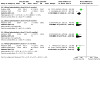
Comparison 1: PKU participants started on diet at diagnosis: diet continuation versus discontinuation/relaxation later, Outcome 1: Blood phenylalanine level (micromol/L)
1.2. Analysis.
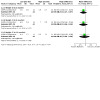
Comparison 1: PKU participants started on diet at diagnosis: diet continuation versus discontinuation/relaxation later, Outcome 2: Weight
1.3. Analysis.
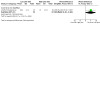
Comparison 1: PKU participants started on diet at diagnosis: diet continuation versus discontinuation/relaxation later, Outcome 3: Intelligence quotient (IQ)
1.4. Analysis.
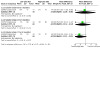
Comparison 1: PKU participants started on diet at diagnosis: diet continuation versus discontinuation/relaxation later, Outcome 4: Calorie intake (kcal/kg)
1.5. Analysis.
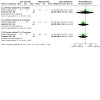
Comparison 1: PKU participants started on diet at diagnosis: diet continuation versus discontinuation/relaxation later, Outcome 5: Protein intake (g/kg)
Comparison 2. PKU participants on strict diet from diagnosis, later relaxed: diet re‐establishment versus continuation.
| Outcome or subgroup title | No. of studies | No. of participants | Statistical method | Effect size |
|---|---|---|---|---|
| 2.1 Blood phenylalanine level (micromol/L) | 1 | Mean Difference (IV, Fixed, 95% CI) | Subtotals only | |
| 2.1.1 Blood phenylalanine level (0 to 3 months) | 1 | 18 | Mean Difference (IV, Fixed, 95% CI) | ‐614.00 [‐867.27, ‐360.73] |
2.1. Analysis.
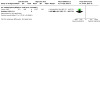
Comparison 2: PKU participants on strict diet from diagnosis, later relaxed: diet re‐establishment versus continuation, Outcome 1: Blood phenylalanine level (micromol/L)
Comparison 3. PKU participants at diagnosis: low‐phenylalanine diet versus moderate phenylalanine diet.
| Outcome or subgroup title | No. of studies | No. of participants | Statistical method | Effect size |
|---|---|---|---|---|
| 3.1 Blood phenylalanine level (micromol/L) | 1 | Mean Difference (IV, Fixed, 95% CI) | Subtotals only | |
| 3.1.1 Blood phenylalanine level (0 to 3 months) | 1 | 132 | Mean Difference (IV, Fixed, 95% CI) | ‐127.10 [‐185.04, ‐69.16] |
| 3.1.2 Blood phenylalanine levels (7 to 12 months) | 1 | 132 | Mean Difference (IV, Fixed, 95% CI) | ‐157.30 [‐217.18, ‐97.42] |
| 3.1.3 Blood phenylalanine level (at 2 years) | 1 | 132 | Mean Difference (IV, Fixed, 95% CI) | ‐84.70 [‐158.02, ‐11.38] |
| 3.1.4 Blood phenylalanine level (at 3 years) | 1 | 128 | Mean Difference (IV, Fixed, 95% CI) | ‐48.40 [‐125.39, 28.59] |
| 3.1.5 Blood phenylalanine level (at 4 years) | 1 | 127 | Mean Difference (IV, Fixed, 95% CI) | ‐78.70 [‐174.49, 17.09] |
| 3.1.6 Blood phenylalanine level (at 5 years) | 1 | 127 | Mean Difference (IV, Fixed, 95% CI) | ‐72.60 [‐162.35, 17.15] |
| 3.2 Weight (kg) | 1 | Mean Difference (IV, Fixed, 95% CI) | Subtotals only | |
| 3.2.1 Weight (0 to 3 months) | 1 | 88 | Mean Difference (IV, Fixed, 95% CI) | ‐0.20 [‐0.47, 0.07] |
| 3.2.2 Weight (4 to 6 months) | 1 | 88 | Mean Difference (IV, Fixed, 95% CI) | ‐0.20 [‐0.56, 0.16] |
| 3.2.3 Weight (7 to 12 months) | 1 | 88 | Mean Difference (IV, Fixed, 95% CI) | ‐0.10 [‐0.58, 0.38] |
| 3.3 Intelligence quotient (IQ) | 1 | Mean Difference (IV, Fixed, 95% CI) | Subtotals only | |
| 3.3.1 IQ at 4 years | 1 | 111 | Mean Difference (IV, Fixed, 95% CI) | 3.00 [‐2.77, 8.77] |
| 3.3.2 IQ at 6 years | 1 | 132 | Mean Difference (IV, Fixed, 95% CI) | 2.00 [‐3.41, 7.41] |
| 3.4 Calorie intake (kcal/kg) | 1 | Mean Difference (IV, Fixed, 95% CI) | Subtotals only | |
| 3.4.1 Calorie intake (0 to 3 months) | 1 | 88 | Mean Difference (IV, Fixed, 95% CI) | ‐1.00 [‐11.06, 9.06] |
| 3.4.2 Calorie intake (4 to 6 months) | 1 | 88 | Mean Difference (IV, Fixed, 95% CI) | ‐3.00 [‐10.12, 4.12] |
| 3.4.3 Calorie intake (7 to 12 months) | 1 | 88 | Mean Difference (IV, Fixed, 95% CI) | ‐6.00 [‐12.51, 0.51] |
| 3.5 Protein intake (g/kg) | 1 | Mean Difference (IV, Fixed, 95% CI) | Subtotals only | |
| 3.5.1 Protein intake (0 to 3 months) | 1 | 88 | Mean Difference (IV, Fixed, 95% CI) | 0.00 [‐0.40, 0.40] |
| 3.5.2 Protein intake (4 to 6 months) | 1 | 88 | Mean Difference (IV, Fixed, 95% CI) | ‐0.10 [‐0.33, 0.13] |
| 3.5.3 Protein intake (7 to 12 months) | 1 | 88 | Mean Difference (IV, Fixed, 95% CI) | ‐0.10 [‐0.31, 0.11] |
| 3.6 Phenylalanine intake (mg/day) | 1 | Mean Difference (IV, Fixed, 95% CI) | Subtotals only | |
| 3.6.1 At 15 months of age | 1 | 151 | Mean Difference (IV, Fixed, 95% CI) | ‐64.00 [‐67.54, ‐60.46] |
| 3.6.2 At 21 months of age | 1 | 138 | Mean Difference (IV, Fixed, 95% CI) | ‐64.00 [‐68.81, ‐59.19] |
| 3.6.3 At 27 months of age | 1 | 141 | Mean Difference (IV, Fixed, 95% CI) | ‐88.00 [‐92.56, ‐83.44] |
| 3.6.4 At 33 months of age | 1 | 139 | Mean Difference (IV, Fixed, 95% CI) | ‐73.00 [‐77.85, ‐68.15] |
| 3.6.5 At 39 months of age | 1 | 134 | Mean Difference (IV, Fixed, 95% CI) | ‐80.00 [‐84.94, ‐75.06] |
| 3.6.6 At 45 months of age | 1 | 141 | Mean Difference (IV, Fixed, 95% CI) | ‐58.00 [‐63.95, ‐52.05] |
| 3.6.7 At 51 months of age | 1 | 125 | Mean Difference (IV, Fixed, 95% CI) | ‐83.00 [‐88.97, ‐77.03] |
| 3.6.8 At 57 months of age | 1 | 119 | Mean Difference (IV, Fixed, 95% CI) | ‐69.00 [‐75.61, ‐62.39] |
| 3.6.9 At 63 months of age | 1 | 115 | Mean Difference (IV, Fixed, 95% CI) | ‐106.00 [‐112.54, ‐99.46] |
| 3.6.10 At 69 months of age | 1 | 117 | Mean Difference (IV, Fixed, 95% CI) | ‐77.00 [‐90.18, ‐63.82] |
3.1. Analysis.
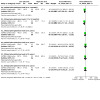
Comparison 3: PKU participants at diagnosis: low‐phenylalanine diet versus moderate phenylalanine diet, Outcome 1: Blood phenylalanine level (micromol/L)
3.2. Analysis.

Comparison 3: PKU participants at diagnosis: low‐phenylalanine diet versus moderate phenylalanine diet, Outcome 2: Weight (kg)
3.3. Analysis.
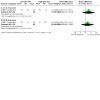
Comparison 3: PKU participants at diagnosis: low‐phenylalanine diet versus moderate phenylalanine diet, Outcome 3: Intelligence quotient (IQ)
3.4. Analysis.
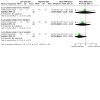
Comparison 3: PKU participants at diagnosis: low‐phenylalanine diet versus moderate phenylalanine diet, Outcome 4: Calorie intake (kcal/kg)
3.5. Analysis.
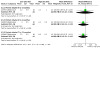
Comparison 3: PKU participants at diagnosis: low‐phenylalanine diet versus moderate phenylalanine diet, Outcome 5: Protein intake (g/kg)
3.6. Analysis.
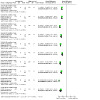
Comparison 3: PKU participants at diagnosis: low‐phenylalanine diet versus moderate phenylalanine diet, Outcome 6: Phenylalanine intake (mg/day)
Characteristics of studies
Characteristics of included studies [ordered by study ID]
Clarke 1987.
| Study characteristics | ||
| Methods | Randomised triple‐blind cross‐over controlled study. Duration 10 weeks. | |
| Participants | 9 participants with PKU (3 males, 6 females, mean age 14.4 years). Low phenylalanine diet commenced early infancy. On relaxed diet prior to study. | |
| Interventions | All participants returned to a low‐phenylalanine diet for the duration of the study. Participants ingested 3 to 4 capsules per day, each containing 500 mg L‐phe during the treatment phase or 500 mg L‐alanine during the control phase. | |
| Outcomes | Blood phenylalanine levels. The following neuropsychological assessments were carried out at baseline and after the first and second phase: WISC‐R, Rosner's auditory analysis test; Raven's coloured progressive matrices; memory for designs; target test; wide range achievement test (arithmetic subtest); finger agnosia; simple reaction time test; choice reaction time test; grooved pegboard test; trail making tests; underlining test; verbal fluency; Stroop colour word interference test. | |
| Notes | 2 participants had continued on a phenylalanine‐restricted diet prior to commencing the study. | |
| Risk of bias | ||
| Bias | Authors' judgement | Support for judgement |
| Random sequence generation (selection bias) | Unclear risk | Method of randomisation not given. |
| Allocation concealment (selection bias) | Unclear risk | Not discussed. |
| Blinding (performance bias and detection bias) Participants | Low risk | Triple‐blinded. Participants continued on their usual diet but with the phenylalanine content of the diet manipulated by using additional supplements. |
| Blinding (performance bias and detection bias) Clinicians | Low risk | Triple‐blinded. |
| Blinding (performance bias and detection bias) Outcome assessors | Low risk | Triple‐blinded. |
| Incomplete outcome data (attrition bias) All outcomes | Low risk | Intention‐to‐treat analysis was employed. |
Griffiths 1998.
| Study characteristics | ||
| Methods | Randomised, triple‐blind, cross‐over study. The study was described as being triple‐blind as neither the children, their parents nor the researchers knew which intervention the children received. Duration 6 months. | |
| Participants | 16 participants with PKU (10 males, 6 females, mean age 12.6 years). All diagnosed by neonatal period and were commenced on a low‐phenylalanine diet within 3 weeks of birth. Diet continued from diagnosis until study entry. | |
| Interventions | Continuation of the low phenylalanine diet in addition to a phenylalanine‐free amino acid supplement for 3 months followed by a low phenylalanine diet plus an amino acid supplement containing phenylalanine for 3 months, or vice versa. | |
| Outcomes | Blood phenylalanine levels measured at baseline and at the end of the first and second 3‐month period. The following neuropsychological tests were carried out at the same time points: matching familiar figures; Rey verbal learning; digits forwards; paired‐associate learning; Corsi block‐tapping; Rey‐Davis manual labyrinth; Purdue pegboard and hole‐type steadiness tester. | |
| Notes | ||
| Risk of bias | ||
| Bias | Authors' judgement | Support for judgement |
| Random sequence generation (selection bias) | Unclear risk | Method of randomisation not given. |
| Allocation concealment (selection bias) | Low risk | Usual formula and experimental product prepared and coded by pharmaceutical company. Key to the code kept by a senior member of the hospital medical staff. |
| Blinding (performance bias and detection bias) Participants | Low risk | Triple‐blinded, neither the children, their parents nor the researchers knew which intervention the children received. Participants continued on their usual diet but with the phenylalanine content of the diet manipulated by using additional supplements. |
| Blinding (performance bias and detection bias) Clinicians | Low risk | Triple‐blinded, neither the children, their parents nor the researchers knew which intervention the children received. |
| Blinding (performance bias and detection bias) Outcome assessors | Low risk | Triple‐blinded, neither the children, their parents nor the researchers knew which intervention the children received. |
| Incomplete outcome data (attrition bias) All outcomes | Low risk | An intention‐to‐treat analysis was employed. |
Holtzman 1975.
| Study characteristics | ||
| Methods | Randomised, controlled parallel study. Duration 2 years. | |
| Participants | 10 participants diagnosed with PKU in the neonatal period and commenced on a low‐phenylalanine diet by 1 month of age, were randomised to either continue on the low‐phenylalanine diet or to terminate the diet at 4 years of age. 5 participants were randomised to each group and the number of males and females in each group was the same (3 males, 2 females). | |
| Interventions | The diet continuation group was continued on a low‐phenylalanine diet. Those in the termination group gradually relaxed the diet following a standard protocol until the diet was unrestricted. | |
| Outcomes | Blood phenylalanine levels were measured at the start of the trial, then at 2, 4, 6 and 8 weeks after the initial time point, and again 6 months, 1 year and 2 years later. Phenylalanine intake was assessed from diet diaries carried out at the same time points as the blood phenylalanine levels. The following physical examinations were carried out when the children were 4, 4.5, 5, 5.5 and 6 years of age: weight gain; height; and head circumference. Neuropsychological examinations were also carried out at these time points and included the following: Stanford Binet intelligence test; the vocabulary; similarities; animal house and the geometric designs subtests of the Wechsler preschool and primary scale of intelligence, auditory and visual sequential memory and auditory reception subtests of the Illinois test of psycholinguistic abilities. A behaviour rating of each child's performance during the test was also obtained. | |
| Notes | ||
| Risk of bias | ||
| Bias | Authors' judgement | Support for judgement |
| Random sequence generation (selection bias) | Unclear risk | Participants randomly allocated, method not given. |
| Allocation concealment (selection bias) | Unclear risk | Not discussed. |
| Blinding (performance bias and detection bias) Participants | High risk | Parents blinded as to which group child was in until time that restricted diet ceased, at which point they knew treatment group. |
| Blinding (performance bias and detection bias) Clinicians | High risk | Not blinded. |
| Blinding (performance bias and detection bias) Outcome assessors | Low risk | Psychological examiner was blinded to diagnosis of PKU. |
| Incomplete outcome data (attrition bias) All outcomes | Unclear risk | Data on some of the participants were missing at several of the intermediate time points and at the end of the study, reasons for drop outs given (Holtzman 1975). |
US/PKU Collaborative.
| Study characteristics | ||
| Methods | Randomised controlled parallel study. Duration 12 years, but in some participants, outcomes were assessed into adulthood. | |
| Participants | 216 infants diagnosed with PKU. Diet was initiated within 121 days after diagnosis. A relatively high proportion of participants was excluded or withdrew from the study following randomisation. | |
| Interventions | At diagnosis participants were randomised to follow either a low‐phenylalanine diet or a moderate‐phenylalanine diet until they were 6 years old. At this point they were further randomised to either continue with their diet or terminate dietary restrictions. Participants were then monitored until at least their 12th birthday. | |
| Outcomes | Blood phenylalanine level. Growth and nutritional indices. Nutritional intake. IQ and neuropsychological performance. | |
| Notes | Data were combined in several reports of the study therefore it was not possible to analyse the difference between treatment and control group. The trialists have been contacted for further details. | |
| Risk of bias | ||
| Bias | Authors' judgement | Support for judgement |
| Random sequence generation (selection bias) | Low risk | Treatment groups "randomly formed" using table of random numbers. |
| Allocation concealment (selection bias) | Low risk | Allocation schedule produced by project staff in telephone contact with local clinic staff at participating clinics. |
| Blinding (performance bias and detection bias) Participants | High risk | Not blinded. |
| Blinding (performance bias and detection bias) Clinicians | High risk | Not blinded. |
| Blinding (performance bias and detection bias) Outcome assessors | Low risk | Laboratory analysis at local clinics checked by two reference laboratories. EEGs read at local clinic and Project centre, discrepancies resolved by 'blind reading' by independent third encelphalographer. |
| Incomplete outcome data (attrition bias) All outcomes | Unclear risk | A relatively high proportion of participants were lost to follow up (reasons given) and some participants swapped groups after randomisation (US/PKU Collaborative). |
EEG: electroencephalography PKU: phenylketonuria
Characteristics of excluded studies [ordered by study ID]
| Study | Reason for exclusion |
|---|---|
| Bentovim 1968 | Unclear if randomised and dietary treatment not initiated soon after birth in all participants. |
| Cleary 2006 | Trial of a specific supplement. |
| Epstein 1989 | Not a randomised controlled trial. |
| Frankenburg 1973 | Not a randomised controlled trial. |
| Kakanoglu 2005 | Participants not eligible ‐ paper states 'participants previously untreated'. |
| Koff 1979 | Not a randomised controlled trial. |
| Koletzko 2007 | Trial of a fatty acid supplement. |
| Krause 1985 | Not a randomised controlled trial. |
| Levy 2007 | Trial of a specific supplement. |
| Lou 1987 | Trial of an additional supplement. |
| Pietz 1995 | Trial of tyrosine. |
| Realmuto 1986 | Introduced phenylalanine for one day only. |
| Rey 1996 | Not a randomised controlled trial. |
| Robertson 2004 | Participants previously untreated. |
| Schindeler 2007 | Trial of an additional supplement. |
| Schmidt 1994 | Not a randomised controlled trial. |
| Schmidt 1996 | Not a randomised controlled trial. |
| Smith 1998 | Trial of tyrosine. |
Contributions of authors
For production of the initial review and the updates until 2006:
Vanessa Poustie:
identification of trials from Cochrane Cystic Fibrosis & Genetic Disorders Group Trials Register;
handsearching of the Journal of Inherited Metabolic Disease from 1979 to 1998;
further identification of trials from publication reference lists;
selection of eligible trials;
assessment of trial methodology;
extraction of relevant data from the trials;
input of trial data;
production of the final review;
updating review.
Patricia Rutherford:
selection of eligible trials;
assessment of trial methodology;
extraction of relevant data from the trials;
comment on final draft of review;
comment on updates of review up to and including 2006 update.
Update 2007: Vanessa Poustie remains as lead author and was involved in study selection. Patricia Rutherford is no longer an active author on this review. Joanne Wildgoose is now a new author on this review and was involved in study selection.
Update 2020: Beth Jameson and Tracey Remmington assessed the studies identified by the searches and updated the review for closure accordingly.
Sources of support
Internal sources
No sources of support supplied
External sources
North West NHS Executive Research & Development Directorate Training Fellowship Scheme, UK
British Dietetic Association General Education Trust, UK
-
National Institute for Health Research, UK
This systematic review was supported by the National Institute for Health Research, via Cochrane Infrastructure funding to the Cochrane Cystic Fibrosis and Genetic Disorders Group.
Declarations of interest
Both authors: none known.
Stable (no update expected for reasons given in 'What's new')
References
References to studies included in this review
Clarke 1987 {published data only}
- Clarke JTR, Gates RD, Hogan SE, Barrett M, MacDonald GW. Neuropsychological studies on adolescents with phenylketonuria returned to phenylalanine-restricted diets. American Journal of Mental Retardation 1987;92(3):255-62. [PubMed] [Google Scholar]
Griffiths 1998 {published data only}
- Griffiths P, Smith C, Harvie A. Transitory hyperphenylalaninaemia in children with continuously treated phenylketonuria. American Journal of Mental Retardation 1997;102(1):27-36. [DOI] [PubMed] [Google Scholar]
- Griffiths P, Ward N, Harvie A, Cockburn F. Neuropsychological outcome of experimental manipulation of phenylalanine intake in treated phenylketonuria. Journal of Inherited Metabolic Disease 1998;21(1):29-38. [DOI] [PubMed] [Google Scholar]
Holtzman 1975 {published data only}
- Holtzman NA, Welcher DW, Mellits ED. Termination of restricted diet in children with phenylketonuria: a randomised controlled study. New England Journal of Medicine 1975;293(22):1121-4. [DOI] [PubMed] [Google Scholar]
US/PKU Collaborative {published data only}
- Acosta PB, Trahams C, Wellman NS, Williamson M. Phenylalanine intakes of 1- to 6-year old children with phenylketonuria undergoing therapy. American Journal of Clinical Nutrition 1983;38(5):694-700. [DOI] [PubMed] [Google Scholar]
- Acosta PB, Wentz E, Williamson M. Nutrient intake of treated infants with phenylketonuria. American Journal of Clinical Nutrition 1977;30(2):198-208. [DOI] [PubMed] [Google Scholar]
- Azen C, Koch R, Friedman E, Wenz E, Fishler K. Summary of findings from the United States Collaborative Study of children treated for phenylketonuria. European Journal of Pediatrics 1996;155(Suppl 1):S29-32. [DOI] [PubMed] [Google Scholar]
- Azen CG, Koch R, Friedman EG, Berlow S, Coldwell J, Krause W, et al. Intellectual development in 12-year-old children treated for phenylketonuria. American Journal of Diseases of Children 1991;145(1):35-9. [DOI] [PubMed] [Google Scholar]
- Dobson JC, Williamson ML, Azen C, Koch R. Intellectual assessment of 111 four-year-old children with phenylketonuria. Pediatrics 1977;60(6):822-7. [PubMed] [Google Scholar]
- Fishler K, Azen CG, Friedman EG, Koch R. School achievement in treated PKU children. Journal of Mental Deficiency Research 1989;33(Pt 6):493-8. [DOI] [PubMed] [Google Scholar]
- Holm VA, Kronmal RA, Williamson M, Roche AF. Physical growth in phenylketonuria: II. Growth of treated children in the PKU collaborative study from birth to 4 years of age. Pediatrics 1979;63(5):700-7. [PubMed] [Google Scholar]
- Koch R, Azen C, Friedman EG, Williamson ML. Paired comparisons between early treated PKU children and their matched sibling controls on intelligence and school achievement test results at eight years of age. Journal of Inherited Metabolic Disease 1984;7(2):86-90. [DOI] [PubMed] [Google Scholar]
- Koch R, Azen CG, Friedman EG, Williamson ML. Preliminary report on the effects of diet discontinuation in PKU. Journal of Pediatrics 1982;100(4):870-5. [DOI] [PubMed] [Google Scholar]
- Koch R, Burton B, Hoganson G, Peterson R, Rhead W, Rouse B, et al. Phenylketonuria in adulthood: a collaborative study. Journal of Inherited Metabolic Disease 2002;25(5):333-6. [DOI] [PubMed] [Google Scholar]
- Koch R, Friedman E, Williamson M, Azen C, Blaskovics, Parker G. Report from the U.S. Collaborative Study of diet discontinuation in PKU children. In: 19th International Conference of the Society for the Study of Inborn Errors of Metabolsm;1981; Southampton. Southampton (UK), 1981:No. 6.
- Koch R, Friedman EG, Williamson ML, Azen CG. Preliminary report of the effects of diet discontinuation in phenylketonuria. Journal of Inherited Metabolic Disease 1982;5(Suppl 1):63-4. [Google Scholar]
- Williamson M, Dobson JC, Koch R. Collaborative study of children treated for phenylketonuria: study design. Pediatrics 1977;60(6):815-21. [PubMed] [Google Scholar]
- Williamson ML, Koch R, Azen C, Chang C. Correlates of intelligence test results in treated phenylketonuric children. In: 19th International Meeting of the Society for the Study of Inborn Errors of Metabolism; 1981; Southampton. Southampton (UK), 1981:No. 43.
- Williamson ML, Koch R, Azen C, Chang C. Correlates of intelligence test results in treated phenylketonuric children. Pediatrics 1981;68(2):161-7. [PubMed] [Google Scholar]
References to studies excluded from this review
Bentovim 1968 {published data only}
- Bentovim A. Controlled observations of phenylketonuric children on and during withdrawal from low phenylalanine diet. Archives of Disease in Childhood 1968;43(232):745-6. [DOI] [PMC free article] [PubMed] [Google Scholar]
Cleary 2006 {published data only}
- Cleary MA, Feillet F, White FJ, Vidailhet M, Macdonald A, Grimsley A, et al. Randomised controlled trial of essential fatty acid supplementation in phenylketonuria. European Journal of Clinical Nutrition 2006;60(7):915-20. [MEDLINE: ] [DOI] [PubMed] [Google Scholar]
Epstein 1989 {published data only}
- Epstein CM, Trotter JF, Averbook A, Freeman S, Kutner MH, Elsas LJ. EEG mean frequencies are sensitive indices of phenylalanine effects on normal brain. Electroencephalography and Clinical Neurophysiology 1989;72(2):133-9. [DOI] [PubMed] [Google Scholar]
Frankenburg 1973 {published data only}
- Frankenburg WK, Goldstein AD. Behavioural consequences of increased phenylalanine intake by phenylketonuric children: a pilot study describing a methodology. American Journal of Mental Deficiency 1973;77(5):524-32. [PubMed] [Google Scholar]
Kakanoglu 2005 {published data only}
- Kalkanoglu HS, Ahring KK, Sertkaya D, Moller LB, Romstad A, Mikkelsen I, et al. Behavioural effects of phenylalanine-free amino acid tablet supplementation in intellectually disabled adults with untreated phenylketonuria. Act Paediatrica 2005;94(9):1218-22. [DOI] [PubMed] [Google Scholar]
Koff 1979 {published data only}
- Koff E, Kammerer B, Boyle P, Pueschel SM. Intelligence and phenylketonuria: effects of diet termination. Journal of Pediatrics 1979;94(4):534-7. [DOI] [PubMed] [Google Scholar]
Koletzko 2007 {published data only}
- Koletzko B, Sauerwald T, Demmelmair H, Herzog M, Schenck U, Bohles H, et al. Dietary long-chain polyunsaturated fatty acid supplementation in infants with phenylketonuria: a randomized controlled trial. Journal of Inherited Metabolic Disease 2007;30(3):326-32. [DOI] [PubMed] [Google Scholar]
Krause 1985 {published data only}
- Krause W, Halminski M, McDonald L, Dembure P, Salvo R, Freides D, et al. Biochemical and neuropsychological effects of elevated plasma phenylalanine in patients with treated phenylketonuria. A model for the study of phenylalanine and brain function in man.. Journal of Clinical Investigation 1985;75(1):40-8. [DOI] [PMC free article] [PubMed] [Google Scholar]
Levy 2007 {published data only}
- Levy HL, Milanowski A, Chakrapani A, Cleary M, Lee P, Trefz FK, et al. Efficacy of sapropterin dihydrochloride (tetrahydrobiopterin, 6R-BH4) for reduction of phenylalanine concentration in patients with phenylketonuria: a phase III randomised placebo-controlled study. Lancet 2007;370(9586):504-10. [DOI] [PubMed] [Google Scholar]
Lou 1987 {published data only}
- Lou HC, Lykkelund C, Gerdes AM, Udesen H, Bruhn P. Increased vigilance and dopamine synthesis by large doses of tyrosine or phenylalanine restriction in phenylketonuria. Acta Paediatrica Scandinavica 1987;76(4):560-5. [MEDLINE: ] [DOI] [PubMed] [Google Scholar]
Pietz 1995 {published data only}
- Pietz J, Landwehr R, Kutscha A, Schmidt H, Sonneville L, Trefz FK. Effect of high-dose tyrosine supplementation on brain function in adults with phenylketonuria. Journal of Pediatrics 1995;127(6):936-43. [MEDLINE: ] [DOI] [PubMed] [Google Scholar]
Realmuto 1986 {published data only}
- Realmuto GM, Garfinkel BD, Tuchman M, Tsai MY, Chang PN, Fisch RO, et al. Psychiatric diagnosis and behavioural characteristics of phenylketonuric children. Journal of Nervous and Mental Disease 1986;174(9):536-40. [DOI] [PubMed] [Google Scholar]
Rey 1996 {published data only}
- Rey F, Abadie V, Plainguet F, Rey J. Long-term follow up of patients with classical phenylketonuria after diet relaxation at 5 years of age. European Journal of Pediatrics 1996;155(Suppl 1):S39-S44. [DOI] [PubMed] [Google Scholar]
Robertson 2004 {published data only}
- Robertson L, Lee P, Murphy G, Amos A. A trial to assess the effectiveness of a low phenylalanine diet in adults with previously untreated phenylketonuria (PKU) [abstract]. SHS Inborn Error Review Series (Dietary Management of Inborn Errors of Metabolic Disease) 2004;14:10. [Google Scholar]
- Robertson L, Lee P, Murphy G, Amos A. A trial to assess the effectiveness of a low phenylalanine diet in adults with previously untreated phenylketonuria (PKU) [abstract]. SHS Inborn Error Review Series (Dietary Management of Inborn Errors of Metabolic Disease) 2004;14:18. [Google Scholar]
- Robertson L, Murphy G, Amos A, Lee P, Dent C. A randomised control trial of diet in adults with previously untreated phenylketonuria (PKU) [abstract]. In: Dietary Management of Inherited Metabolic Disease (DMIMD); 2008 April 17-18th; London, UK. 2008:36. [MEDLINE: ]
Schindeler 2007 {published data only}
- Schindeler S, Ghosh-Jerath S, Thompson S, Rocca A, Joy P, Kemp A, et al. The effects of large neutral amino acid supplements in PKU: an MRS and neuropsychological study. Molecular Genetics and Metabolism 2007;91(1):48-54. [DOI] [PubMed] [Google Scholar]
Schmidt 1994 {published data only}
- Schmidt E, Rupp A, Burgard P, Pietz J, Weglage J, Sonneville L. Sustained attention in adult phenylketonuria: the influence of the concurrent phenylalanine blood level. Journal of Clinical Experimental Neuropsychology 1994;16(5):681-8. [DOI] [PubMed] [Google Scholar]
Schmidt 1996 {published data only}
- Schmidt E, Burgard P, Rupp A. Effects of concurrent phenylalanine levels on sustained attention and calculation speed in patients treated early for phenylketonuria. European Journal of Pediatrics 1996;155(Suppl 1):S82-S86. [DOI] [PubMed] [Google Scholar]
Smith 1998 {published data only}
- Smith ML, Hanley WB, Clarke JT, Klim P, Schoonheyt W, Austin V, et al. Randomised controlled trial of tyrosine supplementation on neuropsychological performance in phenylketonuria. Archives of Disease in Childhood 1998;78(2):116-21. [MEDLINE: ] [DOI] [PMC free article] [PubMed] [Google Scholar]
Additional references
Bickel 1953
- Bickel H. Influence of phenylalanine intake on phenylketonuria. Lancet 1953;2:812-3. [DOI] [PubMed] [Google Scholar]
Dixon 1994
- Dixon M. Disorders of amino acid metabolism, organic acidaemias and uria cycle defects. In: Shaw V, Lawson M, editors(s). Clinical Paediatric Dietetics. 1st edition. Oxford: Blackwell Science, 1994:177-209. [Google Scholar]
Elbourne 2002
- Elbourne DR, Altman DG, Higgins JPT, Curtin F, Worthington HV, Vail A. Meta-analyses involving cross-over trials: methodological issues. International Journal of Epidemiology 2002;31(1):140-9. [DOI] [PubMed] [Google Scholar]
Fisch 1997
- Fisch RO, Matalon R, Weisberg S, Michals K. Phenylketonuria: Current dietary treatment practices in the United States and Canada. Journal of the American College of Nutrition 1997;16(2):147-51. [DOI] [PubMed] [Google Scholar]
Michals 1988
- Michals K, Azen C, Acosta P, Koch R, Matalon R. Blood phenylalanine levels and intelligence of 10 year old children with PKU in the National Collaborative Study. Journal of the American Dietetic Association 1988;88(10):1226-9. [PubMed] [Google Scholar]
MRC1 1993
- Medical Research Council Working Party on Phenylketonuria. Recommendations on the dietary management of phenylketonuria. Archives of Disease in Childhood 1993;68(3):426-7. [DOI] [PMC free article] [PubMed] [Google Scholar]
MRC2 1993
- Medical Research Council Working Party on Phenylketonuria. Phenylketonuria due to phenylalanine hydroxylase deficiency: an unfolding story. British Medical Journal 1993;306(6870):115-9. [DOI] [PMC free article] [PubMed] [Google Scholar]
Paine 1957
- Paine RS. The variability and manifestations of untreated patients with phenylketonuria (phenylpyruvic aciduria). Pediatrics 1957;20:290-302. [PubMed] [Google Scholar]
Schulz 1995
- Schulz KF, Chalmers I, Hayes RJ, Altman DG. Empirical evidence of bias. Dimensions of methodological quality associated with estimates of treatment effects in controlled trials. Journal of the American Medical Association 1995;273(5):408-12. [DOI] [PubMed] [Google Scholar]
Scriver 1995
- Scriver CR, Kaufman S, Woo SLC. The hyperphenylalaninaemias. In: Scriver CR, Beaudet AL, Sly WS, Valle D, editors(s). The Metabolic and Molecular Bases of Inherited Disease. 7th edition. New York: McGraw-Hil, 1995:1015-76. [Google Scholar]
Smith 1994
- Smith I. Treatment of phenylketonuria hydroxylase deficiency. Acta Paediatrica Supplement 1994;407:60-5. [DOI] [PubMed] [Google Scholar]
References to other published versions of this review
Posutie 1998
- Poustie VJ, Rutherford. Dietary interventions for phenylketonuria. Cochrane Database of Systematic Reviews 1998, Issue 4. Art. No: CD001304. [DOI: 10.1002/14651858.CD001304] [DOI] [PubMed] [Google Scholar]
Poustie 1999
- Poustie VJ, Rutherford P. Dietary interventions for phenylketonuria. Cochrane Database of Systematic Reviews 1999, Issue 3. Art. No: CD001304. [DOI: 10.1002/14651858.CD001304] [DOI] [PubMed] [Google Scholar]
Poustie 2010
- Poustie VJ, Wildgoose J. Dietary interventions for phenylketonuria. Cochrane Database of Systematic Reviews 2010, Issue 1. Art. No: CD001304. [DOI: 10.1002/14651858.CD001304.pub2] [DOI] [PMC free article] [PubMed] [Google Scholar]


